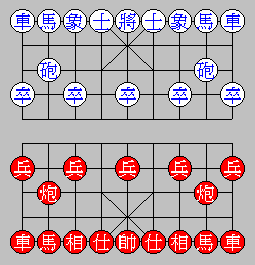

by The Committee of Referees,
Hong Kong Chinese Chess Association
English Translation DRAFTS of Asian Rules by Eric Wu.
You can download the complete HTML Files AsiaRule.Zip and read it off line. The original version of this page can be found at http://www.iponline.com/~txa/xq/
Introduction
Chapter 1 : How to Play Chinese Chess
Chapter 3: How to Staff a Tournament
Chapter 4: Asian Chinese Chess Rules
 The Chinese Chess set includes a board and 32 Chinese Chess pieces
for the two players.
The Chinese Chess set includes a board and 32 Chinese Chess pieces
for the two players.The board has 10 horizontal lines (rows) and 9 vertical lines (files). In the middle of the board the central 7 files are broken to form a horizontal space called the "river". The pieces are placed and move on the intersections of the lines, including on the "river banks" but never in the squares formed by the lines.
The pieces are round and flat; they are identified with Chinese characters. The two sides are usually distinguished with the colors of red and black.
2. Guards are also confined to the center square marked with an X.
Guards move one diagonal space at a time and cannot move horizontally
or vertically. There are two Guards for each side.
3. Ministers' movements are confined to its own territory, which means
a Minister cannot move across the river. Ministers move diagonally and
at two spaces at a time, which means it always moves up or down for
two spaces and left or right for another two spaces. Therefore,
a Minister can only be on seven spots in the board. A Minister can
be "blocked", that is if there is a piece (from either side) in
the next diagonal space of the Minister, the Minister cannot move
toward that direction. There are two Ministers for each side.
4. Rooks can move horizontally or vertically for any empty spaces.
There are two Rooks for each side.
5. Knights can only move one space horizontally or vertically AND
another space diagonally to either forward direction. Knights can
also be blocked. If there is a piece (from either side) right next
to the Knight, the Knight cannot move toward that direction. There
are two Knights for each side.
6. Cannons can move horizontally or vertically for any empty spaces
just like Rooks. However, to take a piece, a cannon has to jump
over another piece (which is called a CANNON MOUNT) from either side.
There is no limit on the empty spaces between Cannon and the cannon
mount or between cannon mount and the piece being taken. There are
two Cannons for each side.
7. Pawns move one space at a time. Before a Pawn moves across the
river, it moves forward only. Once a Pawn has moved across the
river, it can move forward or horizontally to either direction.
A Pawn can never move backward. There are five Pawns for each side.
8. To capture an opponent's piece, one moves a piece legally to the
point which is occupied by the piece being taken. A piece cannot take
another piece from its own side.
9. Kings are not allowed to face each other directly. This means
there must be at least a piece from either side in the vertical line
between the two kings. A King will be captured if it moves into the
"line of sight" of the other King.
10. One side is "checking" if it can capture the other side's King
in the next move. The side being checked should "resolve the check"
or lose. For example, one side checks with a cannon, the other side
can resolve the check by 1) taking the cannon, 2) moving the cannon
mount if the cannon mount is its piece, 3) stuffing another piece
between the cannon and its own king, or 4) moving the King to a
point where it is not threatened with capture or facing the
opposing King.
2. If a player touches a piece, he/she must move that piece.
Some more details:
Section 2: Movements of Pieces
1. King's movements are limited to the center square marked with
an X. King moves one space (step) at a time and can only move
vertically or horizontally. King cannot move diagonally.
There is one King for each side.Section 3: How to play a game
1. A game starts as the Red side takes the first move. After that
the Black side moves, then Red, then Black, and so on. Toss a coin
to decide who play Red. When playing multiple games, the two players
take turns to play Red.
Chapter 2: How to Organize a Tournament
Skipped.
This section is very rigid and boring. The translator takes the
liberty to assume that there is not enough interest. To organize a
tournament, get on ICCS and SHOUT! :-)
Chapter 3: How to Staff a Tournament
Same as Chapter 2.
Chapter 4: Asian Chinese Chess Rules
Section 1 : Terms Used in Defining Asian Rules
Section 2 : Ruling a Game
Four principles in deciding a game with the rules:
Section 3 : General Chinese Chess Rules
While in a perpetual chase, if every move is also an offer to
exchange, it is still a perpetual chase.Section 4 : Detail Rules and Examples
[XQ Homepage]